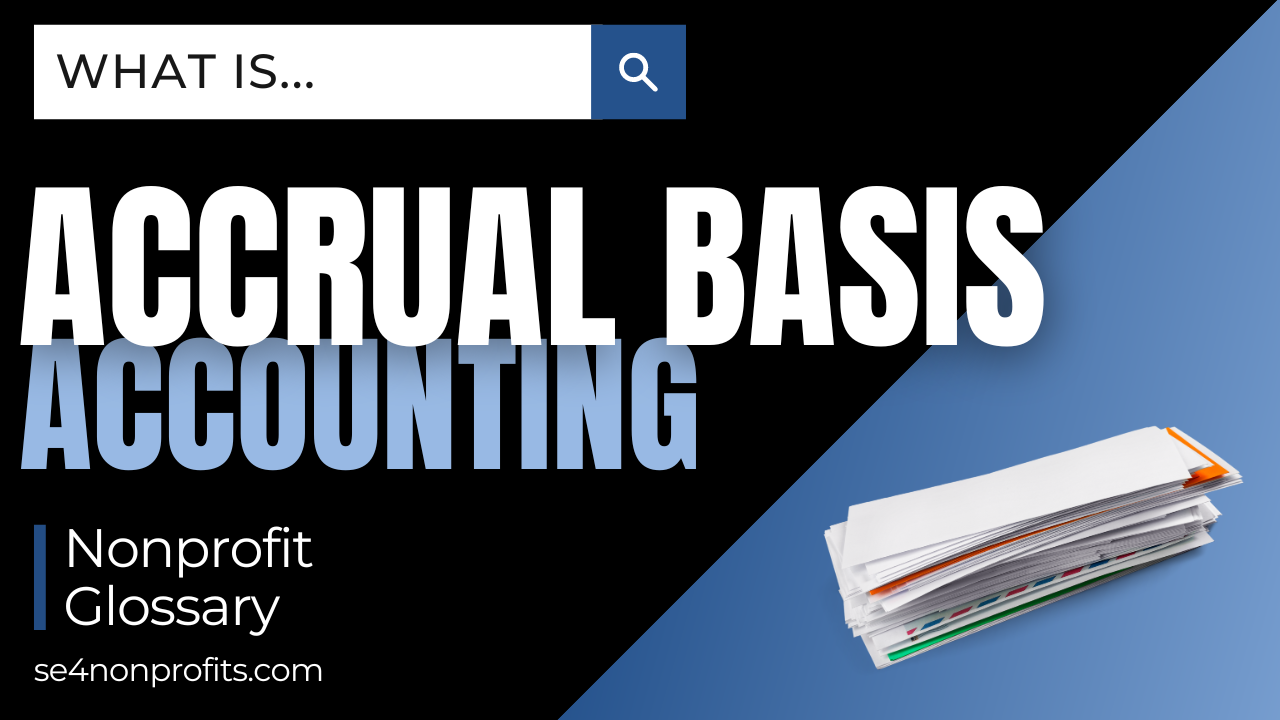
Blog.
Most Recent Posts
![VIDEO Q&A for Subscribers: July 2024 [SUBSCRIBERS-ONLY]](https://images.squarespace-cdn.com/content/v1/5e6ccadfb4659c1d51df14d5/aac04086-c784-4878-b7d8-4a2f376d10a3/SE4N+Video+Q%26A+2024-07.png)
VIDEO Q&A for Subscribers: July 2024 [SUBSCRIBERS-ONLY]
Ben and Mike answer questions from subscribers about the definition of cash basis accounting and its consequences, implications of Board term holdover language and legal remedies to hold organizations accountable for not following their Bylaws, the benefits of tracking volunteer hours and what this means for an organization’s Form 990 and financial statements.

VIDEO: What is Accrual Basis Accounting? | Nonprofit Glossary
SE4N's A. Michael Gellman provides a short summary of the definition of accrual basis accounting, its pros and cons, when accrual basis may not be worth the complication and cost, and what nonprofit organizations can do to ease the transition to accrual basis accounting.

VIDEO: Applying the Segregation of Duties Principle | 5-Minute Lessons 4 Nonprofits
SE4N's A. Michael Gellman provides a short lesson on the importance of the segregation of duties (SOD) principle to nonprofit organizations, explaining how SOD is crucial not just for its standard checks and balances role, but also to help ensure that a transaction or process is a good use of resources, aligns with the mission, and enhances sustainability.

VIDEO: What is Cash Basis Accounting? | Nonprofit Glossary
SE4N's A. Michael Gellman provides a short summary of the definition of cash basis accounting, its pros and cons, what types of nonprofit organization's typically use cash basis accounting, and when it may be time to think about switching to accrual basis.

Q&A #147 – Must a Form 1099 be issued for expense reimbursements paid to Board members and volunteers?
IRS guidance suggests that reimbursements paid to Board members and volunteers for expenses properly incurred in connection with organization functions are generally not required to be reported on Form 1099 if the expense reimbursements are made pursuant to a reimbursement arrangement that qualifies as an “accountable plan.” This is similar (but not identical) to the rules that apply to employee expense reimbursements and Form W-2 reporting.
![Regular Communication Between Development and Finance Departments is Essential for Donor Management [SUBSCRIBERS-ONLY]](https://images.squarespace-cdn.com/content/v1/5e6ccadfb4659c1d51df14d5/1708829199672-XQNOJI61DNDSNNBFEDCL/pexels-alex-andrews-821754.jpg)
Regular Communication Between Development and Finance Departments is Essential for Donor Management [SUBSCRIBERS-ONLY]
Donors are one of the most precious sources of funding for publicly supported nonprofit organizations. Managing this resource is critical to sustainability, continuity, and financial health. There are many important elements to donor management, but these elements will be rendered almost useless without consistent pathways of communication and sharing of information between development and finance departments.
![The Case for Capitalizing Portable Electronic Devices (PEDs) [SUBSCRIBERS-ONLY]](https://images.squarespace-cdn.com/content/v1/5e6ccadfb4659c1d51df14d5/1708829753340-FXKX30FD1R3ASK09NL3B/nastya-dulhiier-Ihi56-Qs39U-unsplash.jpg)
The Case for Capitalizing Portable Electronic Devices (PEDs) [SUBSCRIBERS-ONLY]
Nonprofit organizations are now accustomed to living with changing conditions. Change can come in many different forms, from dramatic and fast (remote working, inflation) to subtle and out of sight (technology, rules, and regulations). A noteworthy example involves portable electronic devices (PEDs), which have seen subtle steady changes leading to lower cost with expanded performance and capacity. These changes have led to new risks that deserve special attention.
![How Nonprofits Can Better Manage Overhead Expenses [SUBSCRIBERS-ONLY]](https://images.squarespace-cdn.com/content/v1/5e6ccadfb4659c1d51df14d5/1709126597632-SJHVEWF0DRESA41HDB7F/joanna-kosinska-bF2vsubyHcQ-unsplash.jpg)
How Nonprofits Can Better Manage Overhead Expenses [SUBSCRIBERS-ONLY]
Managing a nonprofit organization’s overhead (management and general) expenses is just as important as managing program and fundraising expenses. Most nonprofits would not dispute this statement. However, most organizations tend to put an inordinate focus on managing program and fundraising expenses and ignore or not give equal attention to managing overhead expenses.
![Applying Segregation of Duties Beyond Standard Checks and Balances [SUBSCRIBERS-ONLY]](https://images.squarespace-cdn.com/content/v1/5e6ccadfb4659c1d51df14d5/1703076274184-7X2WNVD9MZLG1MQWZF0R/claudio-schwarz-YxywelymVuE-unsplash.jpg)
Applying Segregation of Duties Beyond Standard Checks and Balances [SUBSCRIBERS-ONLY]
Segregation of duties is a bedrock principal of internal accounting control systems and is visible in many elements of nonprofit organization accounting policies and procedures. Without segregation of duties, internal accounting control systems would not be safe or effective. Less often recognized is the powerful impact segregation of duties can have when applied to operational planning and resource management.
![Enhanced Management Strategies for Indirect Costs [SUBSCRIBERS-ONLY]](https://images.squarespace-cdn.com/content/v1/5e6ccadfb4659c1d51df14d5/1709126523556-UU7SPG0LT9HK0SVBH80S/tablet-254581_1920.jpg)
Enhanced Management Strategies for Indirect Costs [SUBSCRIBERS-ONLY]
There are many aspects to consider when it comes to managing a nonprofit organization’s indirect costs. We often think first about compliance rules, which are naturally complicated and can vary by funding source and an organization’s own internal accounting policies and procedures. One aspect we tend not to emphasize enough is staff and their propensity to be disinterested and disconnected when it comes to considering and managing indirect costs.

Q&A #79 – Can an expense reimbursement policy allow small purchases to be reimbursed without receipts?
It is possible to allow exceptions to the requirement to provide receipts for certain small purchases as part of a clear and detailed expense reimbursement policy for all employees (full and part-time staff and senior management) that is equally disseminated and enforced. However, there should be no blanket exceptions based on a specific dollar amount threshold. Rather, you could include an exception that will allow expense reimbursements to be processed in situations where receipts for small purchases are very difficult to obtain.
![Why Actual Timekeeping is Better Than Estimated Labor Allocations [SUBSCRIBERS-ONLY]](https://images.squarespace-cdn.com/content/v1/5e6ccadfb4659c1d51df14d5/1709126682257-MCT1AEF950UEMB24BZKM/ales-krivec-ZMZHcvIVgbg-unsplash.jpg)
Why Actual Timekeeping is Better Than Estimated Labor Allocations [SUBSCRIBERS-ONLY]
Labor is the largest and most precious resource for nonprofit organizations. Managing labor and directing how this valuable resource will be used are the bases for the most critical management decisions. However, too often nonprofits default to using estimated labor allocations, which is a disservice and often yields misleading results. Using actual contemporaneous timekeeping is the best method to track labor hours and observe and manage the impact that labor has on operations, resources, and financial health.
![Managing Current and Future Impacts of Deferred Income [SUBSCRIBERS-ONLY]](https://images.squarespace-cdn.com/content/v1/5e6ccadfb4659c1d51df14d5/1708349677267-FTZLV4E8WMJF3W5839JZ/pexels-artem-podrez-5025512.jpg)
Managing Current and Future Impacts of Deferred Income [SUBSCRIBERS-ONLY]
Paying closer attention to deferred income performance is a must. Monitoring trends and actively managing deferred income will optimize current and future management of this valuable resource. The best approach is to view deferred income as both a current period key performance indicator (KPI) and a resource to support future activities.

Q&A #47 – Is my nonprofit permitted to record volunteer services as in-kind contributions?
While the Form 990 does not allow inclusion of in-kind gifts of services as revenue, whether volunteer services can be recorded as in-kind contributions under generally accepted accounting principles (GAAP) is a separate issue that is governed by the Financial Accounting Standards Board (FASB), specifically, FASB’s Accounting Standards Codification found at ASC 958-605-25-16, discussed further below. However, regardless of whether these volunteer services can be recorded in the financial statements, tracking and documenting in-kind contributions of goods and services is always important and beneficial to a nonprofit organization.

The Finance Calendar: An Essential Tool that is Useful to All
I need to be more grateful for my “over-worked” and “under-appreciated” finance calendar. In my experience, nonprofit organizations gain comfort from its content and a sense of order and completeness from its structure, as do their many end-users, both inside and outside of the organization.